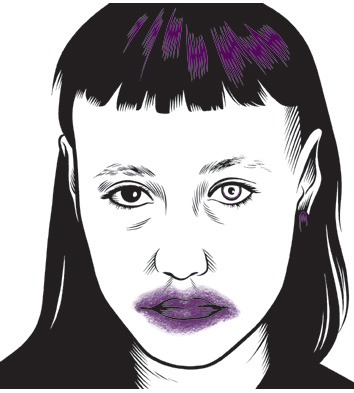In her work with the band CocoRosie, Bianca Casady cross-dresses, raps, plays coffee grinders, and inhabits a series of creative, costume-wearing personas, including one named Rupert, a psychic and a tarot enthusiast. The band, a collaboration with her sister, Sierra, has become known for its signature collage of genres (French jazz, opera), sounds (windup toys, beatboxing), and fashion styles (Victorian, vaudeville, 1990s urban), a divisive cocktail that has pointedly attracted or repelled audiences.
With CocoRosie, Casady is, foremost, a writer. Her poems, transposed into lyrics, tell the story of the band, dictating costumes, artwork, and characters. Sung-spoken with a Billie Holiday timbre and a Wu Tang swagger, the words go deep, both into K-holes of language and the Casady sisters’ past, a sprawling, emotional fairy tale of shaman fathers and long-lost siblings.
In addition to her music, Casady has founded the Voodoo-EROS record label, releasing a motley roster of subversive rappers and songwriters, and Mad Vicky’s Tea Gallery, a temporary art gallery in Paris whose namesake is one of Bianca’s witchy personas. Casady is also an internationally exhibiting artist, and her collages and drawings depict a visual universe not dissimilar to CocoRosie’s, filled with gender-bending unicorns, Native American mythology, and the everyday, man-made spaces she and her sister refer to as “artificial paradise.”
This interview took place backstage at Terminal 5, a few hours before CocoRosie’s most recent performance in New York City, the band’s onetime home before they became, as they are now, itinerant. Casady and I met as we searched for an entrance into the venue, where, later that night, her new video works projected across the stage and the duo performed in vintage pajamas.
—Ross Simonini
THE BELIEVER: CocoRosie seems to be as much about the costumes and the artwork as it is about the music. It’s one big collage of mediums, including your identities or personas, which are always changing. Would you say identity is a part of the CocoRosie project?
BIANCA CASADY: Definitely. Whatever aesthetic phase we’re going through can be accessed through our expression of identity. That comes through in photographs or even how we are onstage. And there will be a correlation between the style of writing and the music on the record. It’s very personal. It’s not something that we attempt to control as much as just serve. But it’s often how we start. A lot of our creative process begins with hair or clothing or makeup. And this is more and more true. I think, from touring so much, and getting ready every night, it’s become the center of everything.
BLVR: Is this a strictly performance-based process or does it cross over into your personal life?
BC: It’s totally a part...
You have reached your article limit
Sign up for a digital subscription and continue reading all new issues, plus our entire archives, for just $1.50/month.
Already a subscriber? Sign in





